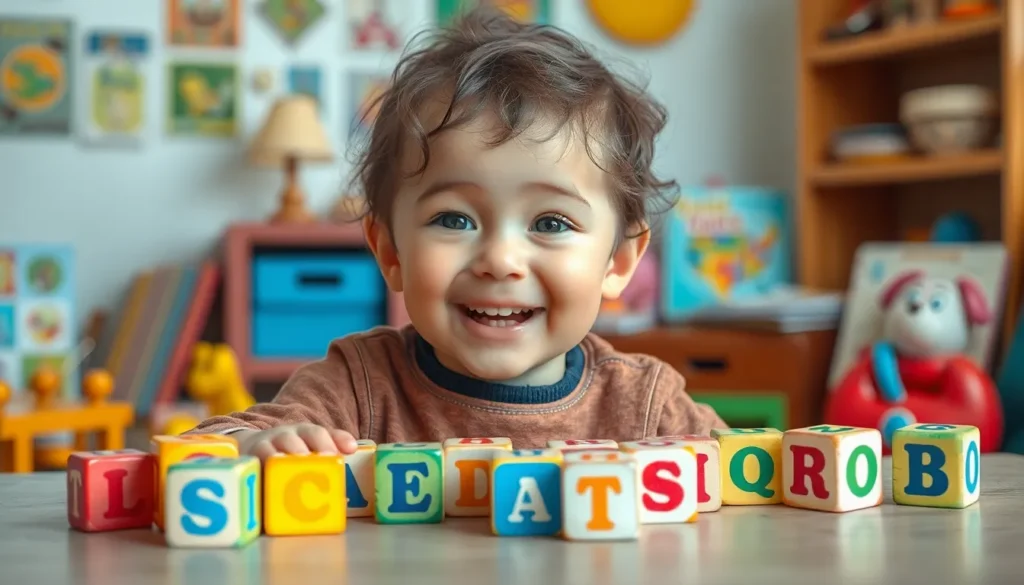Table of Contents
ToggleLanguage acquisition is like a wild rollercoaster ride—full of twists, turns, and the occasional loop-de-loop that leaves you dizzy but exhilarated. From the first babbling sounds of infancy to mastering complex grammar rules as an adult, this journey is nothing short of fascinating. It’s not just about learning words; it’s about unlocking the secrets of communication and connecting with the world around us.
Understanding Language Acquisition
Language acquisition encompasses the process through which individuals learn and master languages. This complex journey integrates various cognitive and social factors.
Theories of Language Acquisition
Several theories explain how individuals acquire language. Behaviorist theory suggests that language learning results from environmental stimuli. In contrast, nativist theory argues that humans are biologically predisposed to develop language skills. Constructivist theory emphasizes the role of social interaction in learning. No single theory fully explains language acquisition; rather, they complement one another by highlighting different aspects of the process.
Stages of Language Development
Language development occurs in distinct stages that reflect growing complexity. Infants begin with cooing and babbling during the initial stage. Around 12 months, they start producing single words. The two-word stage emerges around 18 to 24 months, marking the start of simple sentences. As children progress, they begin to create more complex structures between ages 2 and 3. By age 5, most individuals can formulate intricate sentences and understand grammar rules, showcasing their language proficiency.
Factors Influencing Language Acquisition

Language acquisition involves multiple factors that significantly impact the learning process. Understanding these factors provides insight into how individuals navigate their linguistic journey.
Age and Critical Period
Age plays a significant role in language acquisition. The critical period hypothesis suggests that language learning occurs most effectively during early childhood, particularly before the age of seven. During this time, children’s brains are highly adaptable and capable of absorbing new languages with greater ease. Older learners often face more difficulties in language acquisition because their neural plasticity declines. Neuroimaging studies support this theory, showing enhanced brain activity in younger individuals when exposed to new languages. Additionally, age often correlates with motivation, social contexts, and cognitive abilities, further influencing language learning outcomes.
Environment and Exposure
The environment and exposure to language significantly determine language acquisition effectiveness. Surrounding individuals, such as caregivers, play a crucial role in providing consistent and rich linguistic input. Children exposed to a variety of vocabulary and grammatical structures through conversations, books, and media tend to develop stronger language skills. Opportunities for interaction also contribute. Engaging with peers fosters conversational skills and language use in real-world contexts. Furthermore, cultural influences shape language exposure, introducing specific linguistic nuances. Research indicates that consistent exposure to multiple languages can enhance cognitive flexibility and linguistic proficiency.
Challenges in the Language Acquisition Journey
Language acquisition involves various challenges that learners encounter throughout their journey.
Common Difficulties
Difficulty often arises in mastering pronunciation. Sounds that do not exist in a learner’s native language can create confusion. Additionally, vocabulary retention poses a challenge, especially when new words frequently emerge. Syntax complexity can hinder fluency. Incorrect sentence structures disrupt communication and create misunderstandings. Cultural nuances also complicate language learning, as idiomatic expressions may not translate directly. Learners often experience frustration during these encounters, impacting their overall motivation.
Overcoming Barriers
Strategies exist to help overcome these barriers. Regular practice enhances pronunciation skills, allowing learners to perfect challenging sounds. Engaging with native speakers can improve vocabulary retention and expose students to natural language use. Utilizing language apps or flashcards aids in familiarizing oneself with vocabulary. Learning through context, such as reading books or watching films, deepens understanding of syntax and idioms. Seeking mentorship or joining language groups encourages social interaction, making the process more enjoyable and effective. Consistent engagement and effort drive successful language acquisition despite inherent challenges.
Importance of Language Acquisition
Language acquisition plays a vital role in personal and social development. Understanding various aspects enhances communication skills and cognitive abilities.
Cognitive Development
Cognitive growth significantly benefits from language acquisition. It shapes critical thinking and problem-solving skills. Language skills enable individuals to express their thoughts clearly. Engaging in conversations stimulates mental processes, promoting neural connections. Furthermore, learning new vocabulary and grammatical structures activates different areas of the brain. Research indicates that multilingualism enhances cognitive flexibility and creativity. Children who acquire multiple languages often outperform their peers in tasks requiring complex reasoning. Thus, mastering language contributes to overall intellectual development.
Cultural Awareness
Cultural awareness expands through language acquisition. Language acts as a gateway to understanding diverse traditions and perspectives. Interacting with different languages fosters appreciation for cultural nuances. Exposure to idiomatic expressions deepens insight into the behaviors and values of various communities. Additionally, learning a language often includes exploring its associated cultural artifacts, such as literature and music. This connection strengthens intercultural communication and empathy. Engaging with speakers from different backgrounds nurtures respect and curiosity, ultimately enriching the learner’s worldview. Language acquisition thus facilitates meaningful cultural exchanges.
The language acquisition journey is a complex yet rewarding experience that shapes individuals in profound ways. As learners navigate through various stages and overcome challenges, they not only develop communication skills but also enhance cognitive abilities and cultural awareness. This journey is influenced by numerous factors including age, environment, and exposure, which all play crucial roles in determining success. Embracing the process with patience and persistence allows learners to unlock the full potential of language, fostering deeper connections with others and enriching their understanding of the world. Ultimately, the adventure of learning a language is one that offers lifelong benefits and insights.




